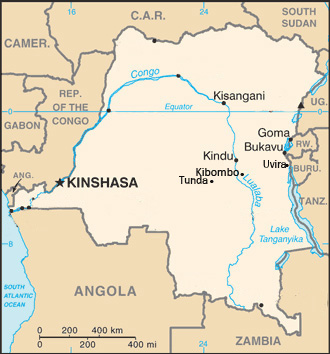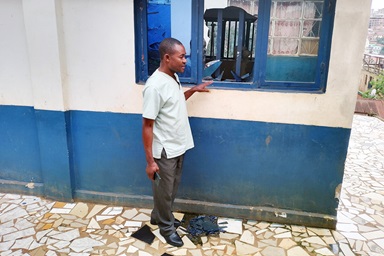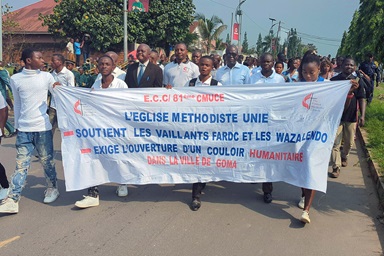In the family of the worldwide United Methodist Church, the East Congo Conference is the infant.
But this baby has a long history.
The denomination’s newest episcopal area was created in 2012. However, “our fathers claimed this episcopal area since 1975,” Bishop Gabriel Unda said.
“Some were chased from the church simply because they asked for an episcopal area. Others remained pastors without having the right to come back again to the church,” Unda said, sitting in his small office at the Lokale Mission that housed missionary families before years of war began.
“Rebels were (once) living here; they used the roof and ceiling as wood to cook their food,” Unda said.
“When we arrived here almost everywhere was the forest, the bush. That’s why we ask our believers as Nehemiah told the people of Israel, ‘Get up and rebuild.’”
Geographically, the East Congo Conference is the largest in the Democratic Republic of Congo. The area defined by this conference encompasses the provinces of Maniema and North and South Kivu to the east — bordering Rwanda, Burundi and Uganda — and Oriental and Equateur across the northern part of the country — which borders South Sudan and the Central African Republic. The episcopal offices are in the city of Kindu, the capital of Maniema Province.
Even today, some parts of the conference are unsafe for travel.
Dangerous places
The Rev. Buera N’Dole is pastor of the Malikale and Wassissi Circuit in the Walikale area of the Goma District, where war never ended.
“There is fighting every day; most of the time we sleep in the jungle and come home during the day,” he said.
His first church was destroyed, his second church burned down and heavy rain swept away his third church.
“Now we are meeting under trees,” he said. He added he does not know when people can attend church from one day to the next, but he has a congregation of 120.
“I am called to be a United Methodist pastor; it is my faith. Christians still have faith,” he said.
N’Dole was one of the pastors who gathered in Goma United Methodist Church at the request of the Rev. Clement Kingombe Lutala, district superintendent. The church in which he is sitting today is badly in need of repair. Rain pours into the building and floods his home and the pastor’s home, both behind the church.
“I keep all my documents in the ceiling to protect them from water,” he said, pointing to his home.
Martin Lubamba, president of United Methodist Men for the conference, said the Goma District has 900 United Methodists. “But we could reach as many as 10,000 with the right resources,” said Lubamba.
Reaching more
Unda dreams of reaching all the people in his conference, but many places are inaccessible. The few roads are hard to travel. His heart is heavy for the tribes of pygmies who live deep in the forests. He also wants to establish women’s centers where rape victims can come for help to reorient themselves back into society.
“We need a United Methodist radio with the capacity to reach even the pygmies,” he said. Unda said the governor has promised to exempt the church from any taxes that would be paid on building a radio station and purchasing equipment.
Unda also is thankful for all the help they have received from United Methodists around the world. For instance, the Tennessee Conference started building his new home and office on the grounds of the mission.
Assistance has come from the United Methodist Board of Global Ministries, United Methodist Committee on Relief, United Methodist Communications, United Methodist Board of Higher Education and Ministry, and annual conferences in the U.S.
One terrible foe he wants to conquer is malaria. He is thankful for the denomination’s international campaign, Imagine No Malaria.
Unda lost his wife eight years ago to malaria. Then he lost his oldest daughter to the disease transmitted by mosquitoes.
“This malaria enters and attacks the bishop’s house. What happens to those living in the forests?” he asked. “I think they suffered enough. Millions have died of malaria.”
Sunday worship
People started lining the winding downhill rocky path to Nazareth United Methodist Church early in preparation for their bishop’s arrival.
Brightly colored cloths were laid out, and when his truck appeared at the top of the hill, they began singing and shouting. A crowd swelled behind him to walk him into church.
All bishops get special treatment when they visit local churches, but the affection the people have for Unda is palpable. They know he has traveled a long way with them.
According to 2013 figures, East Congo has 253,539 professing members, 287 clergy and 416 congregations.
Sylvestre Bushi Moutoma, director of the East Congo episcopal office, said he is very happy promoting the bishop’s mission of “Get up and rebuild.”
“All my life, even when I was little, I have belonged to the church,” he said. “The bishop, who was a pastor at that time, gave me a scholarship to go to school, and when I finished, they gave me work. I am very happy to be a member of this great church.”
Paul Chango N’Djeka, director of Christian education for the conference, said it is his responsibility to send the word of God to the thousands of believers in the large episcopal area.
“Prophet Isaiah said people died because of lack of education,” he said.
Schools with good reputations
Children stand at attention, arranged by age, beneath the gray morning clouds. On cue, they start singing as loudly as they can. Soon they are marching briskly off the dusty square into one of the dilapidated schoolrooms at Mangobo primary and secondary schools in Kisangani.
The grounds include two primary and two secondary schools with 796 primary students and 528 secondary students.
“At the end of the school year. the United Methodist schools have the highest scores,” said headmaster, Nixon Baguma, with a hint of a smile and lots of pride.
No one ever intended for these rooms to be classrooms. They overflow with children learning French and math as well as a variety of other subjects — including the history and religion of The United Methodist Church.
Teachers take shifts with students. One teacher lectures at the front of the room. while two or more others encourage attention and help when a student seems to be falling behind. A right answer earns special clapping: one, two, three, pause, one, two, three, pause and then one hearty clap.
Most of the United Methodist schools from Kinshasa to Uvira are in old structures that are inadequate for the number of students. Most lack libraries, laboratories or workshops. Few have books, pencils or paper.
However, the story is the same from district to district. Parents want their children to attend United Methodist schools because “the church has a good reputation,” said Nichel Shongo Lokale, director of Mangobo School.
Gilbert is a multimedia news reporter for United Methodist News Service. Contact her at (615) 742-5470 or [email protected].
Like what you're reading? Support the ministry of UM News! Your support ensures the latest denominational news, dynamic stories and informative articles will continue to connect our global community. Make a tax-deductible donation at ResourceUMC.org/GiveUMCom.





